26 October 2006:
I revisited a previously collected site at Boskloof for Hyobanche atropurpurea for this day's fieldwork. This site is just east of the Oliphants River Valley, to the south of the Kouebokkeveldberge and east of the Skurweberge. I had been there to collect a couple of times in the past and kind of knew where I was going. The problem once I arrived was that all of my local landmarks had changed. When I first visited the site in 1996 and then again in 2001 the farm had a lot of pine plantations. These have been replaced with fruit orchards since 2001 and I was totally lost in terms of finding the road that led to my field site. After driving around on the farm, getting lost, and trying to find the correct road for about an hour I finally found someone in a bakkie who could put me in touch with the manager who pointed me in the right direction.

The habitat is mountain fynbos and the soil is rocky and sandy.
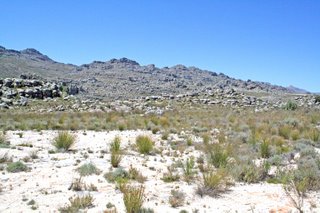
Walking through this fynbos is pretty easy since the soil is like pavement and the shrubs are very compact and short.
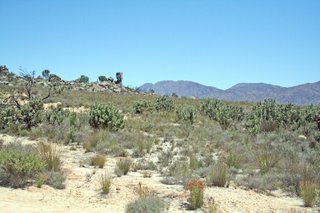
However, it's kind of hard to spot Hyobanche in this habitat since the plants are pretty well camouflaged against the background. Hyobanche atropurpurea is dark purple-black in color and tends to be in the shadow of the shrubs, or so small that at first glance it looks like fallen seed heads from some of the proteas.

Flowering season was well past in this population so I found plants in fruit. I've never been to this site so late in the growing season and was surprised to see what the old flowers had faded to. Instead of being purple-black, they were reddish brown after having been in the sun for a month or more. The corollas and calyxes persist through fruiting. From this specimen, it looks like it was a tough year for the plant. Usually there are 10 or more flowers per inflorescence. Most of the ones I saw here this year had just a few flowers.
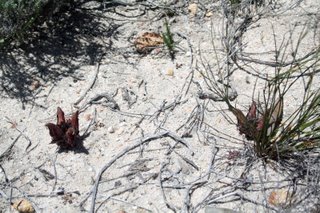
Here's a habitat shot. These plants were in between shrubs.

The pickaxe was needed for this hard, compacted soil.

After the soil is broken up, the delicate work begins. I like seeing those host roots appear straight away.
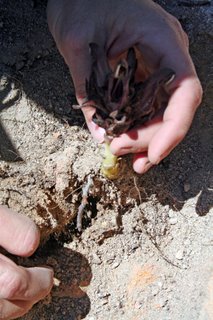
Careful! Don't break the haustorial connections or all that effort is wasted.

Success! That's what I like to see.
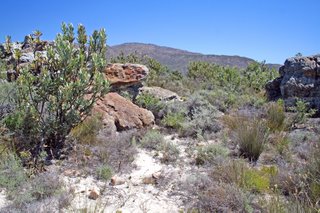
Here's another habitat pic. You might be able to detect the parasitic plants in that open patch of ground in the center. My fieldwork is very much like going on a treasure hunt. Each plant found is a reward for diligence and patience.
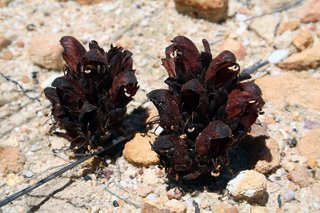
Even past their prime, these plants are attractive.

You can see the challenges for excavation in this picture - all those rocks and the compacted soil make it pretty challenging to have a successful dig.
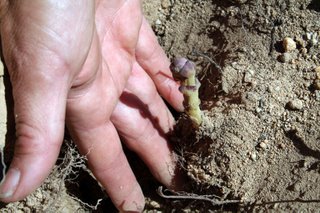
I uncovered a bud on this excavation.
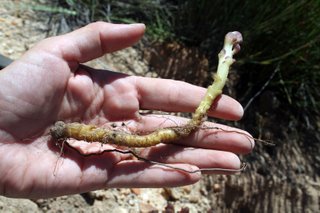
Better yet, this young stem was covered with host root connections.
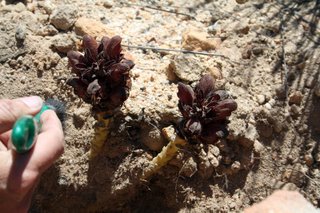
Here I'm going deep to try to see how many rhizomes are associated with this clump.

Wow! What a score! This inflorescence branched off a horizontal rhizome covered with host roots. There's a lot of biomass underground. I wonder just how big each individual plant is.
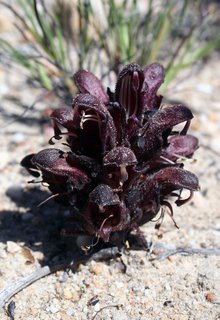
This was the freshest looking inflorescence found at Boskloof and I collected it to send to Gillian Condy who is doing my illustrations for my monograph of Hyobanche.
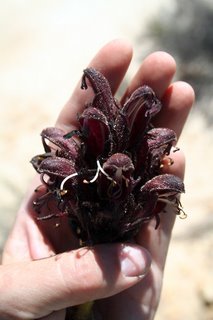
This gives a sense of scale for how big the inflorescence is. I also noticed an interesting morphological character of the stigma.
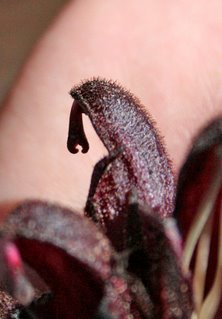 .
.There's a distinctive notch formed by the stigma lobes. I haven't noticed that in other species of Hyobanche.

In addition to Hyobanche atropurpurea, there are a couple of species of Harveya at this site. Harveya is the closest relative to Hyobanche and I had a graduate student, Chris Randle, who worked on this genus for his dissertation. His revision of the South African species of Harveya is now in press at Systematic Botany Monographs.
This is Harveya capensis.

I'm not sure what species of Harveya this is. I'll have to send the pic to Chris for identification.
On the way back to Cape Town, I stopped at Gydo Pass to collect a fresh specimen of Hyobanche sanguinea to send to Gillian along with the H. atropurpurea sample.
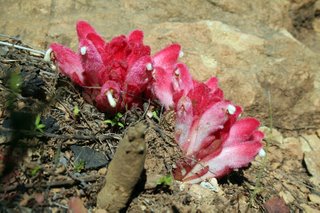
This clump of H. sanguinea was growing out of a road cut at the top of the pass.
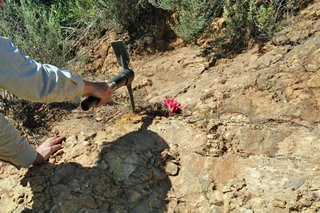
It's a separate population from the one collected at the bottom of the pass, so I sampled it for roots. Not an easy task given the shale it's in. That pickaxe is pretty useful for this work.

It was at a pretty awkward spot, too. I had to perch on a small toehold to reach the plant.

I climbed up to the top of the road cut, but didn't see any other good prospects to sample.




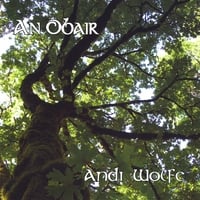






No comments:
Post a Comment